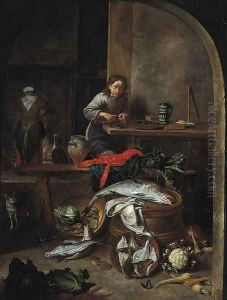Peeter Snyers Paintings
Peeter Snyers, also known as Pieter Snijers, was a Flemish painter, draughtsman, and engraver born on May 19, 1681, in Antwerp, in what is now Belgium. He was the son of Jan Snijers and Maria De Vos. Despite being less well-known than some of his contemporaries, Snyers was a versatile artist whose work encompassed a variety of subjects, including still lifes, genre scenes, and portraits.
Snyers received his artistic training in the studio of Alexander van Bredael, a painter who specialized in market and village scenes. In 1708, he became a master in the Guild of Saint Luke, the city's painters' guild, marking his professional recognition within the artistic community of Antwerp. His early works were influenced by the Baroque style, with an emphasis on vivid colors and dynamic compositions.
Throughout his career, Snyers developed a reputation for his finely executed still lifes, which often included fruit, flowers, and occasionally game. His works in this genre are noted for their meticulous attention to detail and their ability to capture the textures and surfaces of the objects depicted. Like many of his Flemish contemporaries, Snyers paid particular attention to the effects of light and shadow, giving his paintings a sense of depth and realism.
In addition to his still lifes, Snyers painted a number of genre scenes that offer a glimpse into the daily life of his era. These works are characterized by their narrative quality and often include figures engaged in everyday activities. His portraits, though less numerous, are also significant for their psychological insight and the skillful rendering of his sitters' attire and attributes.
Peeter Snyers' contributions to art were not limited to his own creations. He was also involved in art education, becoming a teacher at the Academy of Fine Arts in Antwerp in 1750, where he influenced the next generation of Flemish artists. Snyers remained active in the Antwerp art scene throughout his life, and his works continued to be appreciated for their clarity and precision.
Peeter Snyers passed away on April 11, 1752, in Antwerp. Although he might not have achieved the same level of fame as some of his Flemish peers, his body of work remains a testament to his skills as a painter and his commitment to the artistic traditions of his homeland. Today, his paintings can be found in various museums and collections, where they continue to be studied and admired.
